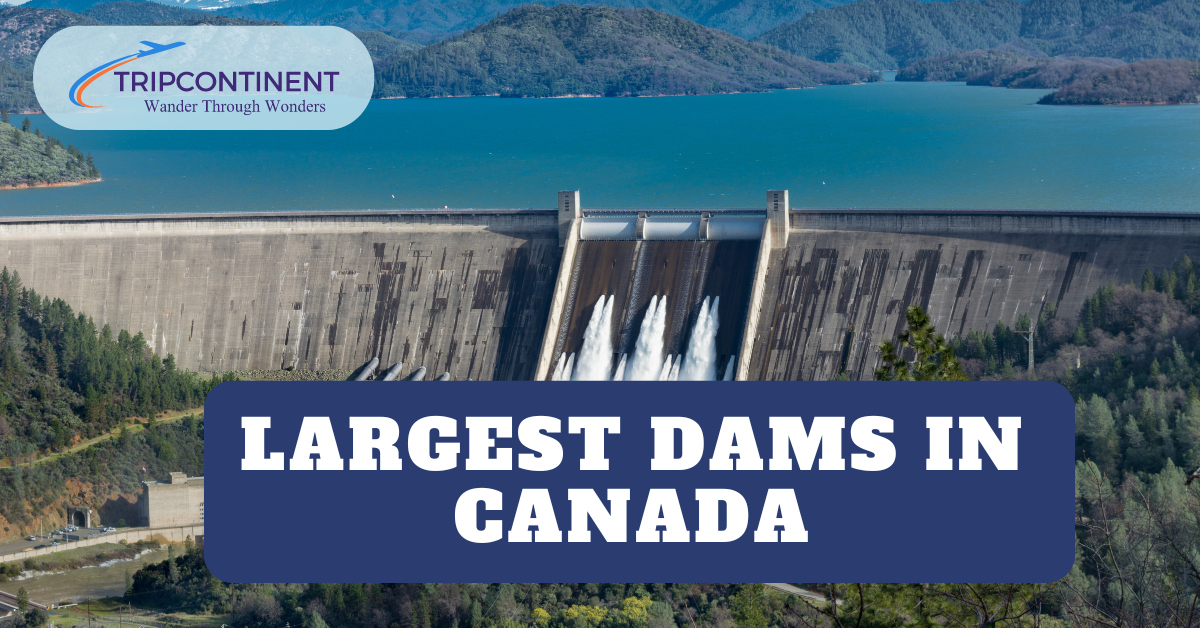Which Are the Largest Dams in Canada in 2024?
Canada’s major hydroelectric dams or immense structures, reflect impressive engineering and serve different purposes. The country is a leading producer of hydroelectric power in North America, generating 60 percent of its power from waterways, an amount second only to China.
From storing water for human consumption and irrigation to protecting water flood discharge, producing hydroelectric power, as well as facilitating water navigation and recreation, these dams play a crucial role in the country’s infrastructure.
Canada has earned the title of hydro superpower and is world famous for its natural resources industries including hydropower. These huge structures are an incredible source of renewable energy, used in various forms and shapes all across the planet. In the 1950s Hydroelectricity dam construction started and progressed into a billion-dollar industry today. In this article, we will have a deeper look at Canada’s largest dams, their reservoir volume, and installed capacity.
List of the Top 5 Largest Dams in Canada
Here is the list of top largest dams in Canada.
- Robert-Bourassa
- Churchill Falls
- Mica Dam
- W. A. C. Bennett Dam
- La Grande-4
1. Robert-Bourassa
Rober-Bourassa, Canada’s largest hydroelectric power station, is located on the La Grande River in northern Quebec. The construction of this largest earth fill in North America was started in 1974 and completed in 1981. About C$3.8 billion was invested to develop this huge generating station. This hydroelectric dam has a capacity to produce 5,616 MW, while its annual generation is approximately 26500 GWh.
Standing 162 m in height and stretching 2,835 m in length, Robert-Bourusa ranks 15th on the list of largest hydroelectric power stations globally, as well as the world’s largest underground power station. The great size of the dam makes it a perfect place for a diverse array of aquatic flora and fauna.
With a total surface area of 2,835 km2, the reservoir capacity of this dam is 61.7 km3. The core of earth fill is composed of glacial moraine and is slightly inclined upstream to increase resistance against the high water pressure in the reservoir.
Its generating station lies around 137.2 m underground, 6 kilometers downstream from the main dam, hosting 16 Francis turbines in two groups of eight each. Robert Bourassa is the most powerful in the Hydro-Quebec network.
Year of Completion: 1981
Installed Capacity: 5616 MW
Volume: 61.7 billion cubic m
Structure Height: 162 m
Read Also: Top 10 Largest Dams in the World
2. Churchill Falls
The Churchill Falls station is well renowned as the second largest dam in Canada after Robert-Bourussa, and the sixteenth largest in the world. With an installed capacity of 5,428 MW, this earthfill generates electricity around 35,000 GWh annually. Its construction period lasted for 7 years, starting in 1967 and ending in 1974. Approximately 946 million CAD had been invested to construct this immense waterway.
The dam stands tall, consisting of 88 dykes and totaling 64 km in height, The total volume of this earth fill is estimated as 2,200,000 m3. Spreading over the catchment area of 71,750 km2, Churchill Falls has a total capacity of approximately 32.64 km3
The dam’s drainage area contains much of western and central Labrador. Studies revealed that the drainage area collected 410 mm of rainfall and 391 cm of snowfall annually, which is equal to 12.5 cu mi of water yearly, and that’s more than enough to meet the project’s needs.
It is one of the world’s largest underground power stations that provides clean, renewable energy to millions of consumers all over North America.
Year of Completion: 1974
Installed Capacity: 5,428 MW
Volume: 2,200,000 m3
Structure Height: 64 km
3. Mica Dam
Mica Dam was entitled as the largest earth fill dam in the world, at the time of its completion in 1971. It is situated in south-eastern British Columbia, Canada.
Standing approximately 250 m in height and having a crest of 1,445 m, this power station is a zoned earth-fill embankment with a glacial till core, as well as sand and gravel shells.
Under the terms of the 1964 Columbia River Treaty, the dam was built as one of the three Canadian projects, and operated by BC Hydro. Renowned as one of Canada’s largest dams, it has a reservoir capacity of 24.762 km3.
While covering a surface area of 430 km2, the installed capacity of the power station is recorded as 2,805 MW.
The purpose behind its construction was to provide 8.6 km3 of water storage, which is outlined in the Columbia River Treaty, and another 6.2 km3 as non-treaty storage.
Year of Completion: 1971
Installed Capacity: 2,805 MW
Volume: 24.762 km3
Structure Height: 250 m
4. W. A. C. Bennett Dam
W. A. C. Bennett Dam also lies among the world’s largest earth fill structures, located on the Peace River in northern British Columbia, Canada. The Finlay, Parsnip, and the Peace River combine into Williston Lake.
Stretching 250 km north to south, and 150 km east to west, the Williston Lake or Williston Reservoir is renowned as the third-largest artificial lake in North America, and the largest freshwater body in British Columbia.
The dam’s construction was started in 1963 and lasted until 1968, taking five years to complete. It is 186 m in height and 2,068 m in length.
With a surface area of 1,761 km2, the reservoir’s total capacity is calculated to be 74 km3.
According to an estimation, $750 million was invested for the dam’s construction. Comprising 10 turbines, this Canada’s power station has an installed capacity of 2,907 MW, along with an annual generation of 15 TWh.
W. A. C. Bennett Dam is popular for holding back the large Williston Reservoir, which can be seen from space.
Year of Completion: 1968
Installed Capacity: 2,907 MW
Volume: 74 km3
Structure Height: 186 m
Read Also: 10 Largest Lakes in the United States You Must Visit
5. La Grande-4
The La Grande-4 ranks among Canada’s largest waterways, opened in 1986. It is an operating hydroelectric power plant, situated on the La Grande River, Quebec.
Sprawling almost 3,800 m in length, this earth fill is 125 m high with a volume of 7,335i m3/s. The spillways at La Grande-4 showcase a curved design that looks like a ski jump.
The total volume of La Grande-4 Reservoir is estimated to be approximately 765 km2. While comprising the installed capacity of 2,779 MW, this majestic hydroelectric generating station produces electricity through the reservoir and dam system.
Year of Completion: 1986
Installed Capacity: 2,779 MW
Volume: 765 km2
Structure Height: 125 m
Table of the Canada’s Hydroelectric Power Stations
| No. | Names of Largest Dams in Canada | Location |
| 1 | Rober-Bourassa | Baie-James, Quebec, Canada |
| 2 | Churchill Falls | Newfoundland and Labrador |
| 3 | Mica Dam | Mica Creek, British Columbia, Canada |
| 4 | W. A. C. Bennett Dam | Hudson’s Hope British Columbia, Canada |
| 5 | La Grande-4 | Baie-James, Quebec, Canada |
Conclusion
Canada boasts a scenic landscape, ranging from spectacular vistas to historical sites, attracting millions of tourists yearly. This captivating country is also enriched with natural resources particularly waterways, comprising over 15,000 dams of which 1,157 are considered as “Large Dams.” The immense structures are owned by the federal and provincial government, irrigation districts, electric utilities, industrial and mining companies, as well as municipalities and private individuals.
From Robet-Brourassa, the country’s largest dam, to the Churchill Falls, one of the world’s largest underground power stations, the Mica Dam, a hydroelectric embankment dam, and the W. A. C. Bennett Dam, crowned for holding back the Williston Reservoir, each earth fill serves as an integral power station in Canada, generating huge amounts of electricity. Come and visit these spectacular waterways to learn more about the impressively designed immense structures.
FAQ’s
What Is the Biggest Dam in Canada?
Robert-Bessara is the largest dam in Canada, standing 162 m tall and spreading 2,835 in width. It is well-renowned for being Canada’s largest hydro project, as well as the world’s ninth-largest hydro project.
How Many Dams Are There in Canada?
According to an estimation, the captivating landscape of Canada consists of 15,000 dams.
Who Is Canada’s Largest Producer of Hydroelectricity?
The extensive network of Hydro-Quebec is considered the largest producer of hydroelectricity in Canada, comprising 61 dams and a combined capacity of 38,400 MW.
What Is the Oldest Dam in Canada?
Milltown Dam is known as Canada’s oldest dam.
What Is Canada’s Largest Energy Source?
Dams are familiar as the largest energy source of Canada, as more than half of electricity is generated from these hydropower stations.

I’m Sophia Jones, an adventurer at heart from New York City, USA. I live for travel and exploration, always eager to discover new places, meet fascinating people, and try out diverse cuisines. Over the past few years, I’ve traveled to numerous countries, immersing myself in different cultures and creating unforgettable memories.






